Church Brasswork
Will Murray
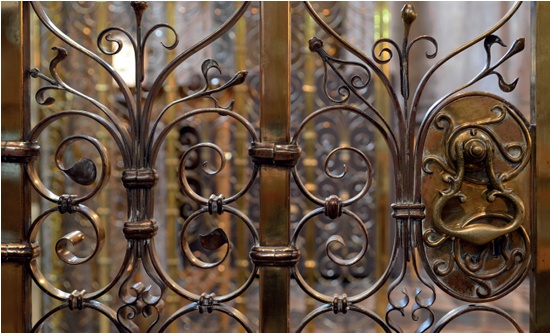 |
|
| Detail of a chancel screen at Bristol Cathedral: the delicate filigree work is vulnerable to mechanical damage, while the handle of the latch is more exposed to chemical residues from bare fingers, and the fine details trap residue from polish (Photo: Jonathan Taylor) |
Brass is an alloy of copper and zinc that has always been favoured for its beauty and workability. In ecclesiastical circles it has a long history of use in fixtures and fittings such as lamps, chandeliers, gates, rails and door furniture, as well as more movable objects such as crucifixes, lecterns, candelabra, jugs, plates and cups. Musical instruments, especially hand-bells and cymbals, also come to mind, and of course brass can be used in the manufacture of organs and organ pipes.
The Romans made great use of brass, for instance in their coinage and armour, and while it has been suggested that the Jews rejected it precisely because of its associations with the Roman occupiers of Palestine, it is likely the Christian church would have made use of brass from its earliest days. In medieval times brass continued to be used although its quality became much more variable. In the modern age the increased understanding of metallurgy and improved methods of manufacture brought brass objects within the reach of any parish, with designs shaped by a variety of influences from the gothic revival to modernism.
This article looks at some of the care and conservation issues that can arise when looking after brass objects. It excludes the care of monumental brasses as these tend to have their own special problems, often due to their location in floors where they are vulnerable to accidental damage and the heavy use that can arise if they are popular for making rubbings (see ‘Monumental Brasses’ by William Lack).
What makes brass so popular for the manufacture of so many items associated with churches and religious practice? As an alloy of copper with zinc, the metal has a range of colours depending on the zinc content. The high-zinc brasses may have up to 40 per cent zinc and are usually a silvery yellow colour, while a low-zinc brass with only 5 per cent zinc might tend towards a pinkish copper colour. The mid-range brasses, which are the most common, typically contain 25-35 per cent zinc and have a warm golden yellow colour. Thus brass exhibits something of the beauty and value of gold with the durability, workability and lower cost of a copper-based alloy. However, unlike gold, it is not inert and it will oxidise slowly if not protected by wax or lacquer.
Sheet brass is made by hot-rolling and cold-rolling cakes of alloy until the desired thickness and size is achieved. The forging and rolling of brass causes work-hardening and embrittlement so the metal has to be annealed in between working – that is, heated to a temperature that allows the metal crystals to rearrange themselves, with the reduction of internal stresses leading to a softening of the brass. Repairs to badly damaged sheet brass artefacts may also require annealing before the metal can be reshaped.
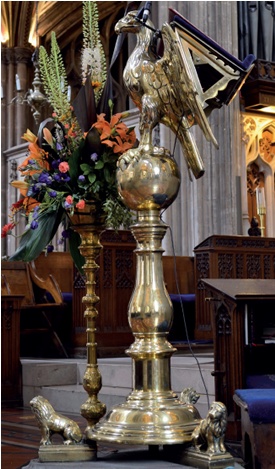 |
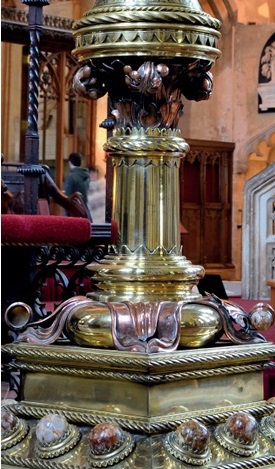 |
|
| An eagle lectern in St Mary Redcliffe, Bristol dated 1638 (left) and a detail (right) of the base of a late 19th-century eagle lectern in Bristol Cathedral: the ornate scroll-work is of copper, which is particularly vulnerable to accidental damage. (Photos: Jonathan Taylor) | ||
Brass for casting can contain some lead as this reduces the melting point and makes it easier to pour when molten. Lead has also been added to brass to make it easier to machine, for example for making plumbing fittings with screw threads. In recent years concerns have been raised about the lead content of brass used for a variety of items, including pipe fittings, due to the leaching of lead into drinking water, and even brass keys due to the potential transfer of lead out of the metal and onto skin during handling.
Today the amount of lead allowed in brass for such uses has been strictly limited in some countries. However, the author is not aware of concerns about the lead in items of church brasswork, presumably because no health problems have been reported or detected.
Brass is relatively resistant to tarnish, yet is malleable and easy to work in sheet form or cast into a mould to make heavier pieces, and components are easily joined together by brazing, soldering or riveting. It also takes well to polishing where the use of increasingly fine abrasives leads to the production of a smooth bright surface. This contrasts with copper and bronze which have less useful working characteristics, and which tend to tarnish rapidly if cleaned and polished. Indeed, bronze and copper are normally deliberately patinated as otherwise the task of maintaining a bright and attractive surface would be endless. But brass can be maintained in a bright state with relatively little effort if the general conditions in which it is kept meet reasonable standards.
Coatings should be mentioned as they can present significant issues. Brass can be gilded either by oil-gilding (when gold leaf is applied to the surface with an adhesive), by mercury-gilding, or by electroplating. The layers of gold applied are very thin and can easily be removed by inappropriate treatment. Brass may also be protected by a durable lacquer which will prevent tarnishing, but if the lacquer is damaged, the exposed area of metal will tarnish, creating visibly darker areas. The most problematic items are those that once had a coat of lacquer which has been partially removed by cleaning and polishing efforts, leaving a sort of patchwork quilt of lacquered brass which remains bright, and unprotected brass which tarnishes comparatively quickly.
What can harm church brasswork? The agents of deterioration include high humidity, which can increase tarnish and corrosion rates, and salts, which can be naturally present in coastal areas but can also come out of walls and floors if there is a lot of moisture movement through the building fabric, and which also encourage corrosion if they come into contact with metal.
Handling brass with the bare hands transfers oils, salts and acids to the metal surface and these can interact with the brass over time to cause finger-marking, tarnishing and corrosion. Of course, many of those who attend church cannot be asked to wear gloves simply to keep the brassware bright, but the staff and volunteers who care for church furnishings can certainly aid matters if they wear gloves when handling bright metals.
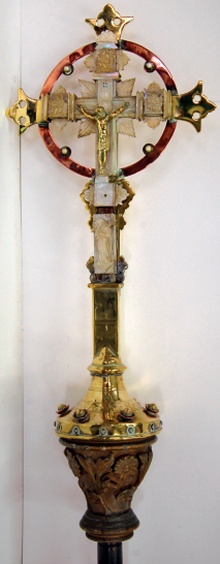 |
|
| Detail of a fine processional cross from St Margaret’s Episcopal Church, Aberdeen, before consolidation and repair: dated 1878, it is a composition of earlier pieces, including a brass crucifix believed to be 15th or 16th century and mother of pearl carvings depicting the evangelists. (Photo: Will Murray) |
Cotton gloves are good for the job, but can be slippery, so some come with special rubber dots on the surface to increase grip. Household rubber gloves are useful as they are hard-wearing, but they are not very sensitive. Disposable latex gloves are useful but can become uncomfortable if worn for long periods, and some people are allergic to latex. Disposable nitrile gloves such as those used in the medical professions (Kimberley-Clark purple nitrile exam gloves for example) are very useful for collection care work as they combine comfort with protection of both the skin and the objects being handled.
Candle wax is rather acidic and will react with the copper in brass to produce green corrosion products, so should not be left in contact for long periods of time. Other acidic materials such as wine and foodstuffs can also attack brass, causing pitting and corrosion if left in contact with the surface.
Soiling is a problem, as dust and dirt are abrasive, and contain materials which encourage tarnishing and corrosion, or when in contact with metals act as sites where corrosion problems can start. If candles are used in the buildings, the soot they produce can slowly build up and soil surfaces, but this is perhaps less of a problem than it once was.
Inappropriate cleaning materials can harm brass by cleaning too aggressively, removing a thin layer of metal each time the object is cleaned; this can eventually cause the loss of surface detail, especially on decorated pieces. Cleaning and polishing materials can also leave residues on the surface and in recesses, often in the form of white deposits of abrasive powders that have not been properly removed. Finally, accidental damage such as scratching, denting or breakage is always a risk, especially when objects are handled or moved.
CARE OF BRASS
When caring for brass artefacts, the best place to start is an assessment of the object’s condition from a conservation perspective. Each artefact is different, with variations in design and manufacture, in decorative surface detail and in current finish or patina, as well as in the way it is used in the church or elsewhere. These variations all contribute to decisions about what care methods to use.
For example, a pair of candlesticks might be small and have a bright finish showing signs of past polishing; in such cases light cleaning might be best. An item might be very large and anyone deciding to embark on a mission to clean and polish it top to bottom might be looking at a full day’s work or even more; is there time available to do a good job? An item might show signs of gilding or lacquering or another surface finish which means that simply applying a metal polish might cause damage or be ineffective; further advice and discussion might be needed. An item might show patchy tarnish and finger-marking which will benefit from the careful application of the right sort of polish. Or a brass item might show a deeply coloured and even coat of tarnish which is aesthetically pleasing in its own right.
Such patinas can become part of the long-term appearance of the artefact and thoughtlessly assuming that ‘all brasswork must be bright’ can lead to the loss of an appearance treasured by others. A non-brass related example would perhaps be the cleaning of the Sistine Chapel frescoes which led to many complaints that they had been over-cleaned and that deliberately-applied materials had been lost along with the soiling.
If your brass is already bright and clean, the best way to manage it is by timely maintenance with light methods of cleaning such as dusting and buffing with a soft cloth. Keep items clean and free of dust and dirt as far as possible; don’t leave food and drink residues on brass plates and cups. Often a wipe over with a damp cloth is sufficient to clean items. Flatware such as plates can be immersed in water with a little washing-up liquid for cleaning, but items with more of a three-dimensional shape may contain voids or even structural elements such as iron rods holding the parts together and immersion is best avoided as any water that gets trapped can cause corrosion. In such cases, wiping with a cloth moistened in warm water with a drop or two of washing-up liquid is probably best.
Brass artefacts known to have lacquered surfaces can also be gently cleaned with a damp cloth. Wax can be a problem on candlesticks and other surfaces, and trying to remove it using tools can cause severe damage to the brass below. There are many recipes for removing wax with both freezing and application of hot water being popular options. It is usually best to use a hairdryer or a hot air blower set to the temperature that will melt the wax without overheating the object. As the wax melts, it can be wiped up with a paper towel and disposed of. Any waxy residues can often be removed with a towel moistened with a little white spirit, a solvent which should be safe on all metal surfaces. Follow safety advice and wear appropriate protective equipment when using solvents such as white spirit.
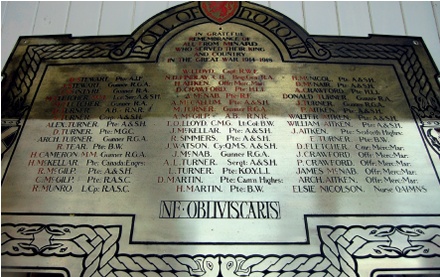 |
|
| A war memorial from Minard, Argyll (above) part way through cleaning showing patchy tarnishing in the uncleaned areas which make the roll of honour difficult to read, and (below) a detail of a plaque with bimetallic corrosion around a fixing (Both photos: Will Murray) |
Handling brass with bare hands, as has been mentioned, leaves oils and salts on the surface which cause tarnishing, so surfaces frequently touched such as a chancel rail will benefit from light burnishing with a soft cloth on a regular basis.
If this proves ineffective in preventing tarnish, the use of a microfibre cloth designed for polishing metals such as brass may be helpful. If necessary, consider using a special brass polishing cloth that has been impregnated with mild abrasives and cleaners.
If the brass item has a thin patchy coat of tarnish, then the use of cloths may not be effective, and in such cases brass polishes should be considered. These come in a great variety, from the gentle to the strong, and it is really a case of horses for courses when it comes to choosing a polish.
Some conservators tend to avoid those brass polishes that leave a powdery residue in recesses, as these can be difficult to remove once they have dried out, and sometimes the rather coarse abrasive can remove more metal than might be desired, but classic products like Brasso polish are still in use in many places.
More gentle options include Duraglit brass polishing wadding and Brasso brass polishing wadding, which are based on petroleum spirit rather than water and thus must only be used while wearing gloves. These waddings tend to turn black when polishing the brass, but careful burnishing after polishing should bring up a bright surface and remove any visible dark residues.
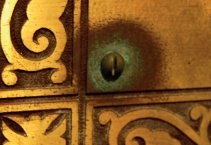 |
The National Trust’s Manual of Housekeeping encourages staff and volunteers who need to polish brass to use Solvol Autosol, a metal polish designed for use on a wide range of metals. It is a fairly strong and effective cleaning and polishing agent so should be used with care. It can certainly be useful when more gentle brass polishes such as the wadding polishes have failed to make an impact. It too turns black as it is used, and if fully burnished out it should not leave any visible residues.
Many commercial polishes contain a mixture of abrasives, chemicals and waxes. The ingredients of any commercial product can often be discovered by searching online for the product name and the MSDS, or Material Safety Data Sheet, which will provide information about ingredients and the health and safety issues involved in the use of the product.
The waxes that are included in polishes are designed to remain on the surface and provide a protective layer against future tarnishing. This is, in principle, a good idea but the wax layer tends to trap abrasives, chemicals, metal fragments and anything else that was on the surface during polishing. Some conservators remove the wax and other polish residues by wiping down the surface with a paper towel or soft cloth moistened slightly with white spirit. Once all the black residues have come away, the surface may be considered to be reasonably clean.
Of course having the wax present is a good idea, as some protection against future tarnishing is certainly helpful. Some institutions go so far as to have protective lacquers applied to their freshly-polished brass, and this can give many years of protection to those items that do not see hard use. However, if the lacquer is damaged, it can lead to rapid tarnishing in the areas where metal is exposed, and then there are decisions to be made about removal and/or replacement, which may require special facilities.
A better answer is a conservation-grade wax polish such as Renaissance Wax. Widely used by conservators, this wax forms a clear self-healing coating on bright metals. It protects to a great extent against dust and humidity as well as handling and tarnish. It can easily be revived by the application of more Renaissance Wax once a year, or as required. It is easily removed with a soft cloth moistened with a little white spirit. If polishing the brass, the wax does not resist the polishing process, and does not have to be specially removed beforehand. The only situation where Renaissance Wax might not be useful is where there is a great deal of complex decoration and it would prove difficult to buff the wax up to a good shine, or on uneven and porous materials such as unvarnished wood where again the wax will be difficult to buff to a transparent coating.
Finally, when it comes to badly damaged brass artefacts, repair is best left to expert metalworkers. Such conservation work might include annealing and reshaping the metal, or joining broken parts using the correct brazing techniques or perhaps the use of cold-setting resins such as epoxy resin. The use of soft lead solder is often seen on brasswork that has been repaired by amateurs wishing to be of assistance, but the results leave much to be desired as dull grey lead has no place on bright yellow brass.
A list of accredited decorative metalwork conservators can be found at the Conservation Register.



